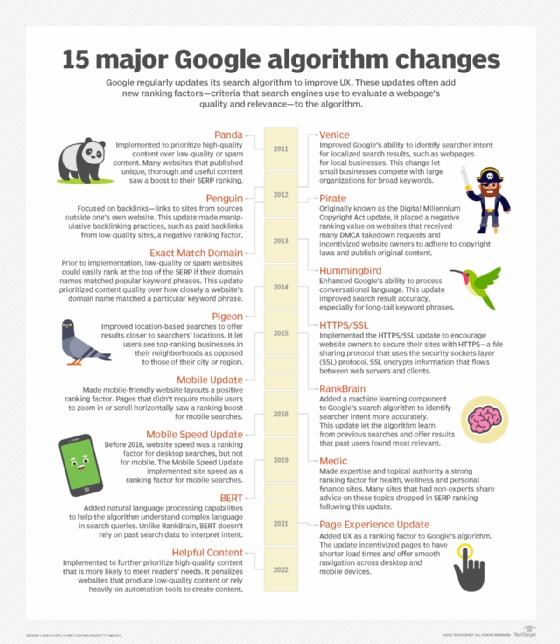
Blue Planet Studio - stock.adobe
Google algorithms explained: Everything you need to know
There are petabytes of information on Google, and its algorithm is the engine that organizes it all.
Google's search algorithm determines what most people -- and probably you -- see when browsing the web.
Google is the most popular search engine with more than 80% of the market share, followed by Bing, Yahoo, Yandex, Baidu and DuckDuckGo, each with less than 10%. Even with Bing's recent AI upgrades, Google dominates the market.
So, whether you're a content creator or a consumer, it pays to know how the algorithm ranks information among the petabytes of data contained in Google search.
What are Google search algorithms?
Google's algorithms are complex mechanisms used to retrieve information from its search index and present the information to a given query. Algorithms sift through billions of pieces of content in Google's index, looking for phrases and keywords that match the query.
Google keeps the details of its search ranking algorithm private but uses hundreds of specific criteria to rank content, including backlinks, page speed and content quality. The search company also regularly updates its algorithm to improve the quality of search results and stay ahead of spammers on the platform.
How does search work?
The search process takes place in three stages:
- Crawling. The search engine's algorithm directs web crawlers to discover URLs on the internet and examine their content. A crawler is a program that runs through content and automatically indexes it.
- Indexing. The content contained in URLs is tagged with attributes and metadata that help the search engine categorize the content.
- Searching and ranking. The user enters a query, and the search engine ranks and returns content in relation to the query.
How does Google's algorithm work?
The algorithm categorizes information based on many factors, but some of the main ranking factors include the following:
- Meaning. This uses language models to decipher the words in a query to match up to useful content. The language models correct spelling and use synonyms to match content to queries even when the web content doesn't contain the exact words. The system will also try to understand the type of information in the search queries. For example, searching for a trending keyword will display more up-to-date information and news. They can also determine if queries have local intent. A search for tacos will return nearby places to get tacos.
- Relevance. The algorithm uses aggregated and anonymized interaction data to assess the relevance of content. The most basic signal for this is matching keywords in content to keywords in the query. If the page contains an exact match, that sends a strong relevance signal to the algorithm.
- Quality. The algorithm looks for signals of expertise, authoritativeness and trustworthiness. One signal of trustworthiness is backlinking from other prominent websites. Another signal is content length. Google continuously measures and assesses the quality of its systems as information on the web is constantly changing.
- Usability. The algorithm prioritizes more user-friendly websites. Examples include mobile friendliness of pages and page load times. If the page uses HTTPS, it also sends a positive signal to the algorithm. Avoiding intrusive ads also helps a page perform well.
- Context. The algorithm looks at information such as location, search history and search settings to return content based on the specific user profile. Search also personalizes results based on previous activity on the Google account. For example, a search for "events near Newton" may affect the results of future searches.
Within these broad categories there are more than 200 specific ranking factors Google uses and constantly augments to provide results based on search queries. The complete list and weights of each ranking factor is unknown, but each aims to validate one of the above five principles in content. It's best to optimize many ranking factors instead of just a few. Some specific factors that content creators can directly measure include the following:
- Content organization. Using subheads and headings -- including rich media and bulleted lists --sends a positive page experience signal to the algorithm. Bulleted lists are more likely to appear in the featured snippet.
- Content length. There is no magic length for content to appear in search results, but a good rule of thumb is longer is better.
- Website structure. An architecture without too many subdirectories can help Google index a page.
- Backlinks. Backlinks -- or links from other sites -- show Google that other sites trust your content.
- Domain authority. This is the metric that gauges a site's authority on a topic. The way to achieve this is through high-quality relevant content with backlinks from other relevant sites.
- Meta descriptions. Meta descriptions containing a keyword can help a page do well.
- Image alt text. Google can't read images, so writing alt text can help describe an image for the algorithm.
- Keywords in H2 and H3. Put keyword variations in the headings of posts.
- Click-through rate. This is the number of users who click on the website link.
- Bounce rate. This measures the number of visitors that arrive then click the back button.
- Dwell time. This measures how long a visitor stays on a page.
Algorithm updates
Google updates its algorithm regularly. When it does, SEO professionals take note because it affects how Google ranks their content. Google makes minor tweaks several times a day. Most of these tweaks aren't noteworthy. Algorithm updates that do significantly affect the search engine results page are called core algorithm updates.
Google doesn't always announce updates. Often, SEO professionals look for signs of an update and report them to each other. Unexplained drops in traffic metrics and conversions are usually a sign that Google is reworking things on its end.
Google usually makes several core algorithm updates per year. Some are designated catchy names by the SEO community or Google itself to help notify people about them, prepare for them and make them easier to refer to.
Google's latest core algorithm update was in March 2023. Some smaller update types include link spam updates, helpful content updates and product reviews updates. Google keeps an updated list of its algorithm changes.

What is next for Google's algorithms?
The recurring theme in Google algorithm updates is that Google wants to present the most in-depth, authoritative, high-quality content possible. As AI chatbots become more competent, Google may incorporate them into search and update its algorithm accordingly, to handle the kinds of queries that come through that interface.
One theoretical development is that Google moves to a real-time algorithm, with fewer punctuated updates and larger updates happening automatically in real time.






